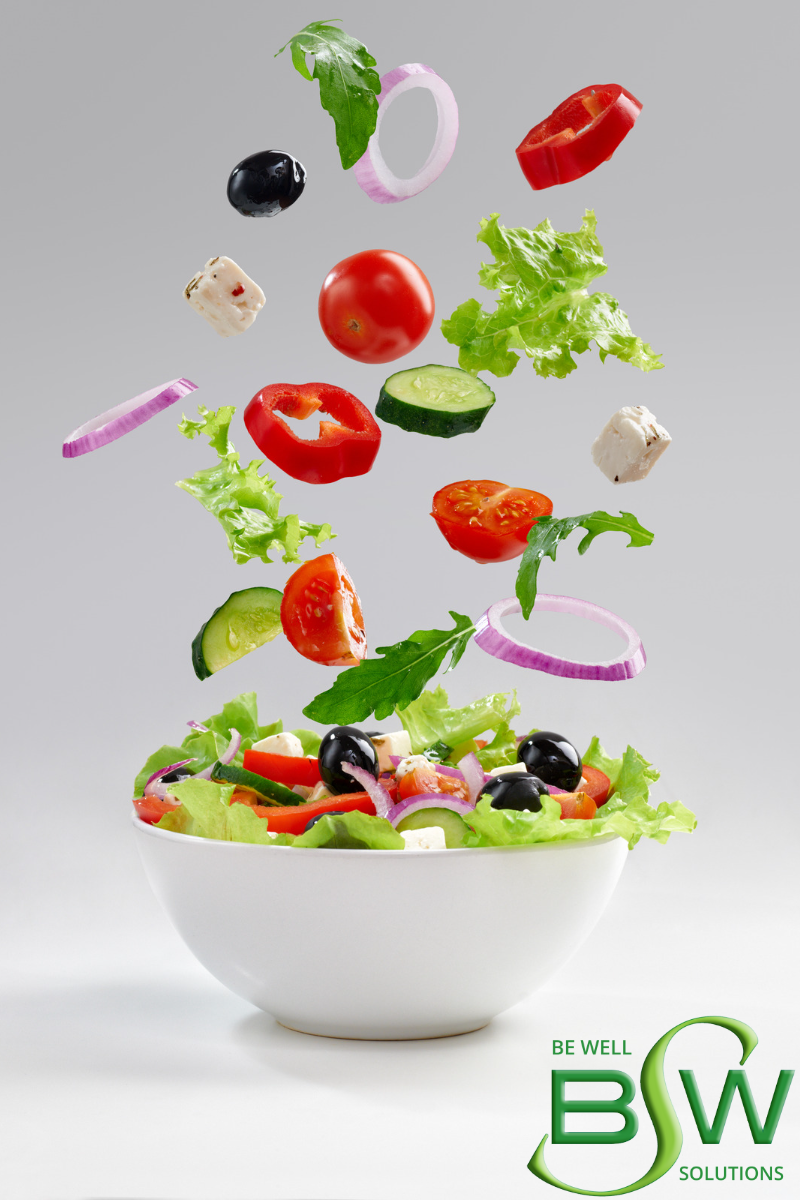
Salads are the image of “health food”. When we think “I’m going to eat healthily”, we often default to salads. Although, when we don’t build a well-balanced salad, we might end up overeating at snacks or later meals. The salad could be loaded with salt and fat and we feel as sluggish as if we had consumed a burger! In between these two extremes is a salad that will help us sustain energy, without yearning for more or feeling too tired to keep moving. This can be a great option if we make a great plan! As fresh vegetable season is around the corner, here is a guide for creating optimal salad combinations.
Plate Method: this encourages a balanced meal with lean proteins, dairy/non-dairy alternatives, vegetables/fruits, grains, and heart-healthy fats. Salads incorporating most, or all, of these in recommended portions are salads that will keep you feeling comfortably full and fueled. Modify as needed if the salad is a side dish, but here is an outline –
- 1-2 cups of non-starchy vegetables (such as lettuce, cucumbers, carrots, and tomatoes). This serving size is about the size of a baseball, but this is the part of the salad that you can add as much as you like! Non-starchy veggies have very few calories, but many health benefits.
- 3-4 oz “lean” protein (chicken, turkey, eggs, tuna, beans, nuts, seeds), about the size of your palm.
- ½ cup fruit (think mandarin oranges/berries on a salad, or a side of fruit), about the size of a tennis ball.
- ½ cup grains (croutons, pasta/rice, whole grain garlic toast, or dinner roll), about the size of a tennis ball, the same as fruit.
- 1 oz cheese, about the size of two dice.
- 1 oz (2 Tablespoons) of dressing, about the size of a golf ball.
Color & Variety: these give salads the vitamins, minerals, and antioxidants we need and want for our best health outcomes. For example, research shows the potential benefit of plant foods and colors on preventing or slowing age-related cognitive decline1 (ARCD). As our society ages, ARCD is something of concern. For variety, try olives, a couple of sundried tomatoes, or some fermented foods like sauerkraut.
Realistic: choose foods you enjoy. Don’t make a salad you won’t want to eat just because someone else says it’s “good for you”. You can always add in some new ingredients here or there if you want, and if they’re ones you’ll want to eat.
Fun: food should be an exciting and inviting experience, not a scary endeavor. Have extra bacon and want a few bacon bits? Crush one strip and add it to the top as a mindful ingredient. Or, top with a handful of extra fried onions from green bean casserole. The presentation, with those sprinkles of fun, can make all the difference to your experience of enjoying the dish!
Cost-effective: words like “artisan” have begun to grace our salad labels, but we can be salad artists without a label and price tag. Again, color, variety, and fun are much more important than trying to shell out dollars on fancy lettuce. It’s 100% okay to explore new ingredients, but a well-designed salad and overall diet don’t require a hefty budget.
Example:
| Ingredient | Serving Size | Price Per Serving (based on prices found at Walmart.com2, April 19, 2023) |
| Mixed Greens or Baby Spinach | 1 cup | $1.82 |
| Heirloom Tomatoes | ½ tomato, diced | $0.62 |
| Cucumbers | ⅓ cucumber, sliced | $0.26 |
| Canned Tuna | ⅔ can tuna, drained | $0.53 |
| Orzo | ½ cup orzo, cooked | $0.16 |
| Feta Cheese | 1 ounce | $0.58 |
| Olives, 3.8oz canned | ¼ can | $0.41 |
| Greek Dressing | 1 ounce | $0.32 |
| Total | Approx. 2.5 cup salad | $4.70 |
(Prices from Walmart)
Here are some more good options that follow the formula above:
Shrimp Cobb Salad with Dijon Dressing
Written by BWS Dietitian: Ivana Petrovic RDN, LD
Continue reading May 2023 Newsletter: Ditch the Diets
